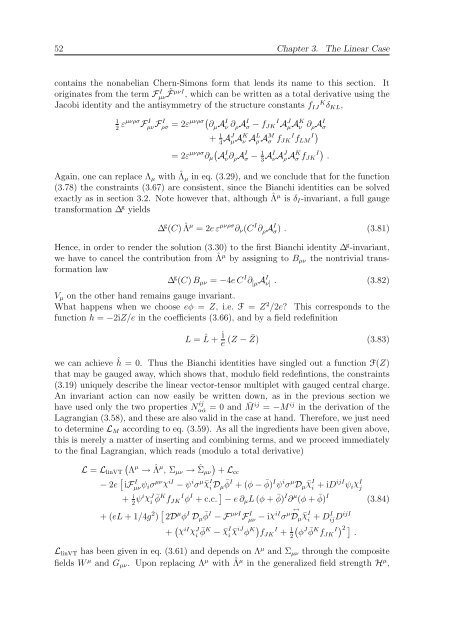N=2 Supersymmetric Gauge Theories with Nonpolynomial Interactions
N=2 Supersymmetric Gauge Theories with Nonpolynomial Interactions
N=2 Supersymmetric Gauge Theories with Nonpolynomial Interactions
Create successful ePaper yourself
Turn your PDF publications into a flip-book with our unique Google optimized e-Paper software.
52 Chapter 3. The Linear Case<br />
contains the nonabelian Chern-Simons form that lends its name to this section. It<br />
originates from the term F I µν ˜ F µνI , which can be written as a total derivative using the<br />
Jacobi identity and the antisymmetry of the structure constants fIJ K δKL,<br />
1<br />
2 εµνρσF I µνF I ρσ = 2ε µνρσ ∂ µA I ν ∂ρA I σ − fJK I A J µA K ν ∂ρA I σ<br />
+ 1<br />
4AJ µA K ν A L ρ A M σ fJK I fLM I<br />
I<br />
Aν∂ρA I σ − 1<br />
= 2ε µνρσ ∂µ<br />
3 AI νA J ρ A K σ fJK I .<br />
Again, one can replace Λµ <strong>with</strong> ˆ Λµ in eq. (3.29), and we conclude that for the function<br />
(3.78) the constraints (3.67) are consistent, since the Bianchi identities can be solved<br />
exactly as in section 3.2. Note however that, although ˆ Λ µ is δI-invariant, a full gauge<br />
transformation ∆ g yields<br />
∆ g (C) ˆ Λ µ = 2e ε µνρσ ∂ν(C I ∂ ρA I σ) . (3.81)<br />
Hence, in order to render the solution (3.30) to the first Bianchi identity ∆ g -invariant,<br />
we have to cancel the contribution from ˆ Λ µ by assigning to Bµν the nontrivial transformation<br />
law<br />
∆ g (C) Bµν = −4e C I ∂ [µA I ν] . (3.82)<br />
Vµ on the other hand remains gauge invariant.<br />
What happens when we choose eφ = Z, i.e. F = Z 2 /2e? This corresponds to the<br />
function h = −2iZ/e in the coefficients (3.66), and by a field redefinition<br />
L = ˆ L + i e (Z − ¯ Z) (3.83)<br />
we can achieve ˆ h = 0. Thus the Bianchi identities have singled out a function F(Z)<br />
that may be gauged away, which shows that, modulo field redefintions, the constraints<br />
(3.19) uniquely describe the linear vector-tensor multiplet <strong>with</strong> gauged central charge.<br />
An invariant action can now easily be written down, as in the previous section we<br />
have used only the two properties N ij<br />
α ˙α = 0 and ¯ M ij = −M ij in the derivation of the<br />
Lagrangian (3.58), and these are also valid in the case at hand. Therefore, we just need<br />
to determine LM according to eq. (3.59). As all the ingredients have been given above,<br />
this is merely a matter of inserting and combining terms, and we proceed immediately<br />
to the final Lagrangian, which reads (modulo a total derivative)<br />
µ<br />
L = LlinVT Λ → Λ ˆ µ<br />
, Σµν → ˆ <br />
Σµν + Lcc<br />
− 2e iF I µνψiσ µνχ iI − ψ i σ µ ¯χ I<br />
i Dµ ¯ φ I + (φ − ¯ φ) I ψ i σ µ Dµ ¯χI<br />
i + iD ijI ψi χI j<br />
+ i<br />
2 ψiχ J i ¯ φ K fJK I φ I + c.c. − e ∂µL (φ + ¯ φ) I ∂ µ (φ + ¯ φ) I<br />
+ (eL + 1/4g 2 ) 2D µ φ I Dµ ¯ φ I − F µνI F I µν − iχiI ↔<br />
µ<br />
σ Dµ ¯χI<br />
+ χ iIχ J i ¯ φ K − ¯χ I<br />
i ¯χiJ φ K fJK I + 1<br />
2<br />
i + D I ijD ijI<br />
φ J ¯ φ K fJK I 2 .<br />
(3.84)<br />
LlinVT has been given in eq. (3.61) and depends on Λ µ and Σµν through the composite<br />
fields W µ and Gµν. Upon replacing Λ µ <strong>with</strong> ˆ Λ µ in the generalized field strength H µ ,

















